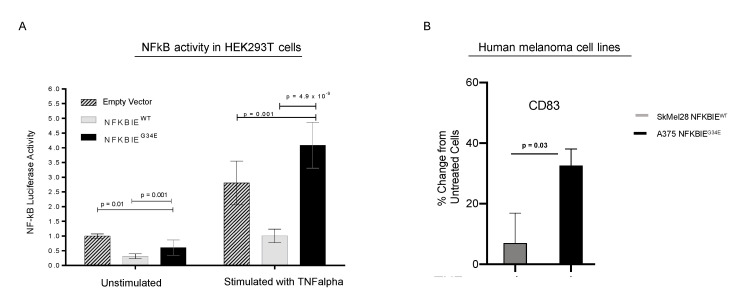Figure 4.
In vitro experiments to assess the effect of NFKBIE G34E on the NFKB pathway. Functional analysis of the NFKBIE G34E variant and wildtype was performed. Cells were stimulated with TNFalpha and monitored for NFkB activity via luciferase reporter assay or protein expression of CD83 by flow cytometry. (A) HEK293T cells were transiently transfected with a luciferase-based NFkB reporter, then either: empty vector or plasmids containing the NFKBIE G34E or NFKBIE wildtype cDNA sequences. Under TNFalpha stimulation, NFKBIE G34E transfected cells displayed an increase in luciferase activity when compared to cells transfected with empty vector (p = 0.001), and wildtype transfected cells (p = 4.9 × 10−9). When cultured without TNFalpha, transfected cells exhibited a decrease in luciferase activity. Values were normalized to empty vector in unstimulated conditions. (B) Flow cytometry analysis for CD83 in human melanoma cell lines that are NFKBIE wildtype and NFKBIE G34E mutant (SKMel28 and A375, respectively). Data are represented as the percent change in protein expression as compared to unstimulated cells. When stimulated, the A375 cell line showed a greater increase in CD83 protein expression as compared to SkMel28 (p = 0.03). For panels (A,B) all p-values were calculated using an un-paired t-test with Holm–Sidak correction for multiple tests. Data represent the standard deviation of the mean. The experiments were performed in technical triplicates, and independently repeated three times.

